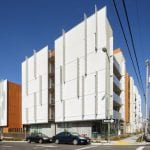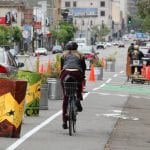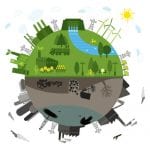This has been a year of transition and revitalization at Urban Ecology. The Board of Directors and staff spent much of 2003 developing a new strategic plan. The result is new mission and visions statements – see below – and a re-tooling of the way we integrate our planning and policy work.
Urban Ecology has a long and proud history of practicing quality urban design in low-income communities and advocating for visionary policies that promote local and regional sustainability. In 2004 and beyond, we will build on this legacy with a new emphasis on creating safe, sustainable and vibrant neighborhoods. As our mission statement reflects, we believe that vibrant neighborhoods – where there is affordable housing, choices for transportation and safe open spaces – are fundamental to sustainable regions.
There are organizations in the Bay Area working from the “top down” to promote regional sustainability through policy reform; Urban Ecology’s emphasis is from the “bottom up,” starting with our hands-on neighborhood planning, where we translate what we hear in places like East Oakland into planning models and policy reform that can make all urban communities healthier, safer and more livable. To turn this new vision into a reality, we have added three new and very talented staff members – Jess Wendover, Robert Hickey and Noé Noyola, who you will be hearing more about in this issue and in future editions. For more information about our strategic plan, see www.urbanecology.org.
Our Mission
Vibrant neighborhoods are the building blocks of healthy cities and thriving regions. Urban Ecology uses urban design, land use planning and policy reform to help people plan and build communities that are ecologically healthy, socially just and economically fair.
Our Vision
Urban Ecology’s vision of a sustainable Bay Area is premised on a deep and abiding belief in cities, and in the variety and diversity nurtured by cities that are ecologically healthy and socially just. Diversity is a core value running through our work:
We support diversity in the built environment by promoting mixed land uses with a range of housing types and jobs, different kinds of open spaces and choices for transportation;
We promote diversity in the social fabric by planning and advocating for places that provide for a mix people with a range of needs, backgrounds and income levels.
We employ a democratic, participatory process for promoting sustainable development that is based on drawing out the diverse values, hopes, priorities and needs of a community’s stakeholders.





